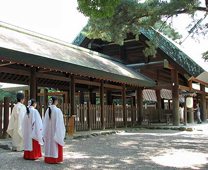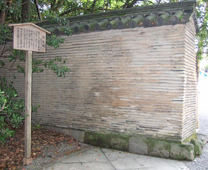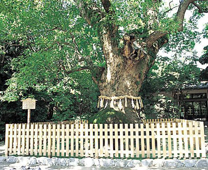
Travel Guide
Atsuta Shrine is one of Shinto's most important shrines. It enshrines Five Great Gods of Atsuta including the Sun Goddess Amaterasu and stores the sacred sword Kusanagi-no-tsurugi, which is one of the three imperial regalia. The 200,000-square-metre (2,200,000 sq ft) shrine complex draws over 9 million visitors annually, including those who practice the conventional New Year visit.
In addition to the famous scenic spots, the origin of Atsuta Shine has a profound relationship with Japanese mythology. It is a shrine full of fantasy mythology. Atsta shrine stores sacred sword Kusanagi-no-tsurugi, one of the three sacred treasures that symbolize the Imperial throne. In the shrine, there are also gods representing authority and force. Therefore, from ancient times, Atsuta Shrine is an important shrine following the Ise Shrine for the Japanese royal family, ranking second only to the Ise Shrine, and also one of the most important shrines in Japan.
Atsuta Shrine was originally founded about 1900 years ago, when the sacred sword Kusanagi-no-tsurugi was enshrined. The Shinto Shrine is believed to have been established to house the legendary sword, and is said to safeguard it for the Imperial household. Atsuta was chosen as the site for the shrine by Miyasuhime-no-Mikoto, daughter of Owari-no-kuni-no-miyatsuko and wife of the then Prince Yamatotakeru-no-Mikoto, who had died leaving the sword in Hikami.
Atsuta Shrine is not only an important shrine of the Japanese royal family, but also loved by local residents. During the reign of the 12th emperor of Japan, there was already a long-standing belief in Atsuta Shrine. The shrine is familiarly known as Atsuta-Sama (Venerable Atsuta) or simply as Miya (the Shrine).
Atsuta Shrine occupies an area of about 190,000 square meters, centered on the main palace and associated palace, and has 8 auxiliary shrines and 18 subordinate shrines. The shrine grounds include a 1,300 year old giant camphor tree said to be planted by the renowned Buddhist priest Kobou Daishi, ponds, Nobunaga Bei, a 7.4m high tile topped mud wall donated and built to protect the shrine by the warlord Oda Nobunaga following his victory at the Battle of Okehazama in 1560 and a Noh theater. Atsuta Shrine's treasure hall houses over 4,000 relics, 174 of which are designated Important Cultural Properties, and a National Treasure designated dagger. The Atsuta Jingu Museum preserves and displays a variety of historic items, including sacred garments, manuscripts, masks, mirrors, furniture, and a large collection of swords. Displays are changed monthly.
Atsuta Shrine is seen as a protector of the area's agriculture and the shrine's festivals include an opulent planting ceremony. Throughout the year over 70 festivals are held within the shrine's large precincts with the main festival Hatsu-Ebisu, dedicated to Ebisu for good fortune in business, which held on June 5.
The shrine buildings were maintained by the effort of devout generals of successive times, such as the Shoguns of Muromachi and Edo Shogunates, Nobunaga, Hideyoshi, and the Tokugawas, ruling family of Owari district. In 1893 the shrine was remodeled into Shinmei-zukuri structure, the same style of building as the Great Shrine of Ise. On the occasion of Sengu celebration in 1935 the shrine buildings as well as other facilities were completely rearranged and improved so that it came to assume the grandeur true to the Great Shrine of Atsuta. During the World War 2, however, more of its buildings were destroyed by fire.
After the war the reconstruction was begun by the combined effort of all devout worshippers of the shrine all over the country. The main buildings were completed in 1955 to enable Hondensenzasai to be celebrated there. The remaining construction was steadily under way to perfect the shrine as a great spiritual center equipped with modern facilities for cultural activities as well.
 |
 |
 |
| Worship Hall | Nobunaga Bei | Giant camphor tree |
Travel Advice
Three sacred treasures
Kusanagi-no-tsurugi is likened to Britain’s Excalubur. According to the eighth Century compiled kojiki, the oldest extant chronicle of Japan, the god, Susanoo found the sword in the tail of an eight headed dragon he had slain. The sword was later presented to the goddess Amaterasu, and later presented to the warrior Yamato Takeru, who used it’s magical powers to cut his way out of a grass fire started by a treacherous enemy warlord, hence it’s moniker, the Grass Cutting Sword.
The other two treasures are: YATA-NO-KAGAMI--a large mirror. It is said that when Amaterasu-omikami hid in the Amanoiwato rock cave, Ishikoridome-no-mikoto made and offered it up to Amaterasu-omikami. It is kept in Ise Jingu (Ise Shrine) in Mie Pref. It is an object of worship and believed to contain the spirit of a deity.
YASAKANI-NO-MAGATAMA--an accessory from ancient times. When Amaterasu-omikami hid in the Amanoiwato rock cave, gods offered it up to her. It is kept in the Imperial Palace.
Five Great Gods of Atsuta
All of whom are mythologically connected with the sacred sword. Among them, are Takeinadane-no-Mikoto and Miyasuhime-no-Mikoto, first parents of Owari-Uji, indigenous people of Nagoya and its neighboring districts. These two gods are said to have shown many divine virtues in accordance with teaching of Amaterasu-Oomikami.
Nobunaga Bei
At the battle against Imagawa Yoshimoto, Oda Nobunaga prayed for victory at Atsuta Shrine. After the battle (the battle of Okehazama) he offered walls to Atsuta Shrine in thanks of the victory. This is one of the three valuable dobei (soil wall), so called big 3 walls in Japan, after Taikoh-bei(Sanjuusangen-do in Kyoto) and Ooneri-bei (Nishinomiya Jinja in Hyogo Pref.)
Main events held in the shrine
- Hatsu-Ebisu (January 5): Dedicated to Ebisu for good fortune in business.
- Yodameshi Shinji (January 7): Fortells rainfall for the coming year, as determined by the amount of water collected in a pot below the eastern Treasure House.
- Touka Shinji (January 11): A variation of the Heian Period (10-12thCentury) Imperial Court ceremony Touka-no-sechie, praying for strong crop yields.
- Hosha Shinji (January 15): Ceremony involving shooting arrows at a wooden target.
- Bugaku Shinji(May 1): A Heian Period ceremonial dance performed out of doors.
- Eyoudo Shinji (May 4): A festival commemorating the return of the sacred sword .
- Shinyo-Togyo Shinji (May 5): A festival to offer prayers for the security of the Imperial palace. A portable Mikoshi shrine is carried in a procession to the Western Gate.
- Rei Sai (June 5): Various portable mikoshi shrines are carried along the approaches to the shrine, and at night, sets of 365 traditional lanterns light up the gates. Exhibitions of judo, swordsmanship and archery are presented for the gratification of the deities.
Visit
| Address | 1-1-1 Jingu, Atsuta-ku, Nagoya-shi, Aichi | |
| Phone | 052-671-4153 | |
| Admission | Free | |
| Hours | Free time | |
| Closed | Open 7 Days a Week | |
| Duration | 30 minutes | |
| Getting There | By Train 8 minute walk from Atsuta Station on JR Tokaido Honsen. By Car Take Nagoya Express to the HOrita exit. It is approximately 10 minutes from exit. |
|
| Parking | Parking available | |

